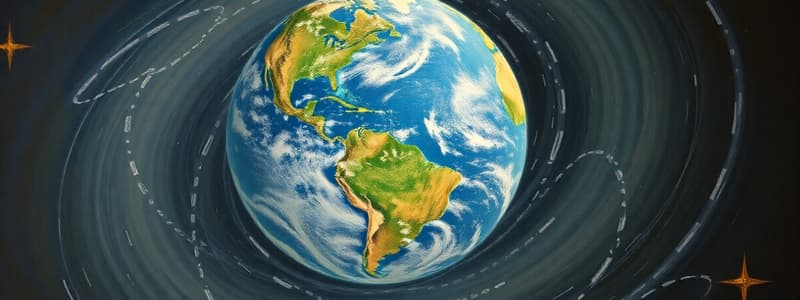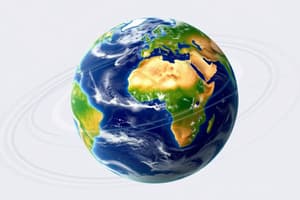Podcast
Questions and Answers
What direction does the Earth rotate?
What direction does the Earth rotate?
- North to South
- East to West
- West to East (correct)
- South to North
What is the main subject of the handwritten notes?
What is the main subject of the handwritten notes?
- Visual Arts
- Geographical Mapping
- Angular Measurement (correct)
- North Direction
The Earth's axis of rotation is not parallel to its position during seasonal changes.
The Earth's axis of rotation is not parallel to its position during seasonal changes.
False (B)
What is the Coriolis effect?
What is the Coriolis effect?
The notes suggest that angular measurement is irrelevant to geography.
The notes suggest that angular measurement is irrelevant to geography.
What measurement is referred to as being taken from the North?
What measurement is referred to as being taken from the North?
The ______ pendulum provides evidence of Earth's rotation.
The ______ pendulum provides evidence of Earth's rotation.
Match the following effects of Earth's rotation with their descriptions:
Match the following effects of Earth's rotation with their descriptions:
The notes refer to __________ measurement on the horizon from the North.
The notes refer to __________ measurement on the horizon from the North.
Match the following terms with their definitions:
Match the following terms with their definitions:
What is the primary reason for the creation of time zones?
What is the primary reason for the creation of time zones?
As latitude increases, the rate of Earth's rotation increases.
As latitude increases, the rate of Earth's rotation increases.
What is the effect of Daylight Savings Time on the standard clock?
What is the effect of Daylight Savings Time on the standard clock?
There are ___ time zones around the world, each ___ degrees wide.
There are ___ time zones around the world, each ___ degrees wide.
Match the following concepts with their correct descriptions:
Match the following concepts with their correct descriptions:
What occurs during the Summer Solstice?
What occurs during the Summer Solstice?
Aphelion is when the Earth is closest to the Sun.
Aphelion is when the Earth is closest to the Sun.
What is the angle of the Earth's axial tilt?
What is the angle of the Earth's axial tilt?
The position of the Earth closest to the Sun is called __________.
The position of the Earth closest to the Sun is called __________.
Match the following events with their corresponding dates:
Match the following events with their corresponding dates:
What is the definition of an equinox?
What is the definition of an equinox?
The Tropic of Capricorn is located at a latitude of 23.5° S.
The Tropic of Capricorn is located at a latitude of 23.5° S.
What are the highest and lowest latitudes where the Sun's direct rays hit during a solstice?
What are the highest and lowest latitudes where the Sun's direct rays hit during a solstice?
The angle between the horizon and an object in the sky is called _____ .
The angle between the horizon and an object in the sky is called _____ .
Match the following latitude lines with their descriptions:
Match the following latitude lines with their descriptions:
Flashcards
Earth's Axis of Rotation
Earth's Axis of Rotation
An imaginary line passing through Earth, connecting the North and South poles.
Earth's Rotation
Earth's Rotation
The Earth turns on its axis from West to East, completing one full rotation in about 24 hours.
Coriolis Effect
Coriolis Effect
The tendency of objects moving on or above Earth's surface to be deflected due to varying rotation speeds at different latitudes.
Parallelism of Earth's Axis
Parallelism of Earth's Axis
Signup and view all the flashcards
Foucault Pendulum
Foucault Pendulum
Signup and view all the flashcards
Solar Noon
Solar Noon
Signup and view all the flashcards
Standard Time
Standard Time
Signup and view all the flashcards
Time Zones and Travel
Time Zones and Travel
Signup and view all the flashcards
Daylight Savings Time
Daylight Savings Time
Signup and view all the flashcards
International Date Line
International Date Line
Signup and view all the flashcards
Parallax
Parallax
Signup and view all the flashcards
Aphelion
Aphelion
Signup and view all the flashcards
Perihelion
Perihelion
Signup and view all the flashcards
Earth's Tilted Axis
Earth's Tilted Axis
Signup and view all the flashcards
Summer Solstice
Summer Solstice
Signup and view all the flashcards
What is altitude?
What is altitude?
Signup and view all the flashcards
What is a solstice?
What is a solstice?
Signup and view all the flashcards
What is an equinox?
What is an equinox?
Signup and view all the flashcards
What is the Tropic of Cancer?
What is the Tropic of Cancer?
Signup and view all the flashcards
What is the Tropic of Capricorn?
What is the Tropic of Capricorn?
Signup and view all the flashcards
Horizon from the North Pole
Horizon from the North Pole
Signup and view all the flashcards
Angular Measurement
Angular Measurement
Signup and view all the flashcards
Angular Measurement on the Horizon
Angular Measurement on the Horizon
Signup and view all the flashcards
Horizon Perpendicular to Earth's Axis
Horizon Perpendicular to Earth's Axis
Signup and view all the flashcards
Object Rotation from North Pole
Object Rotation from North Pole
Signup and view all the flashcards




